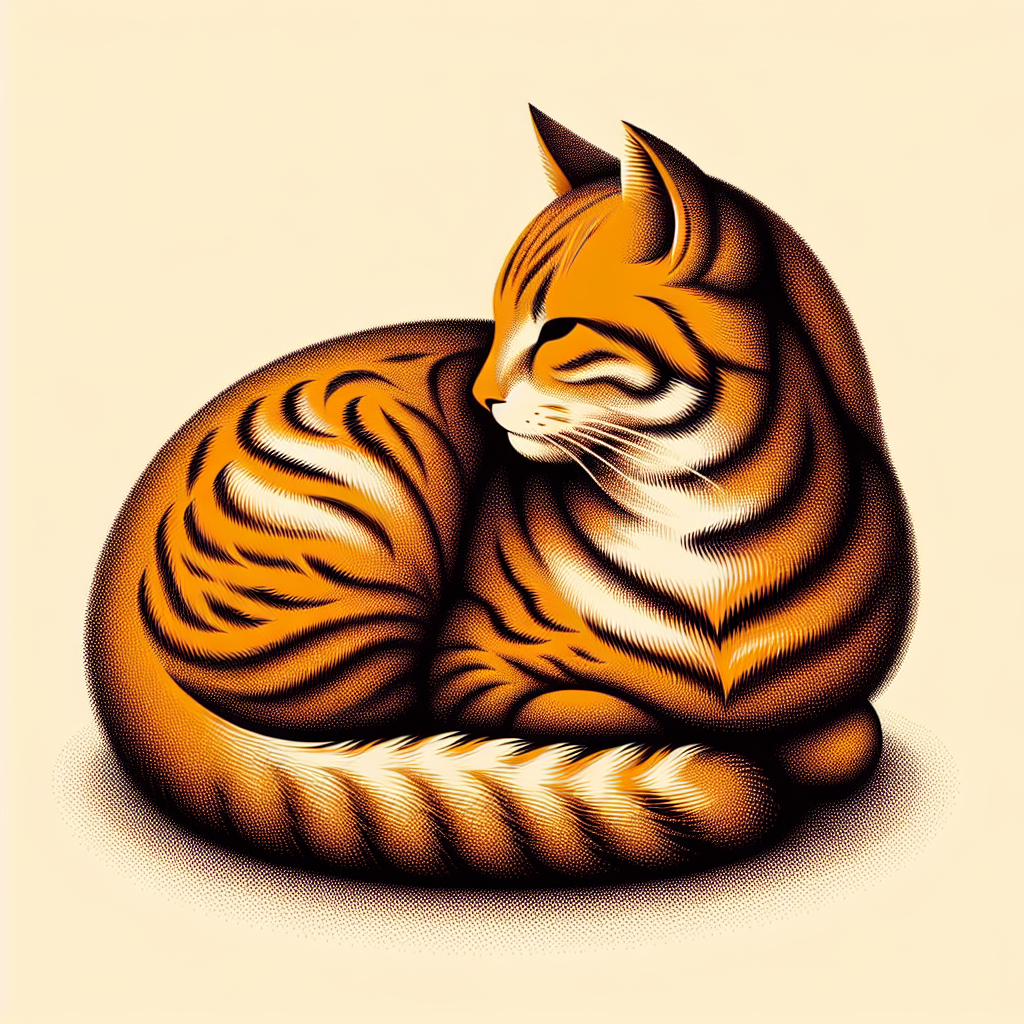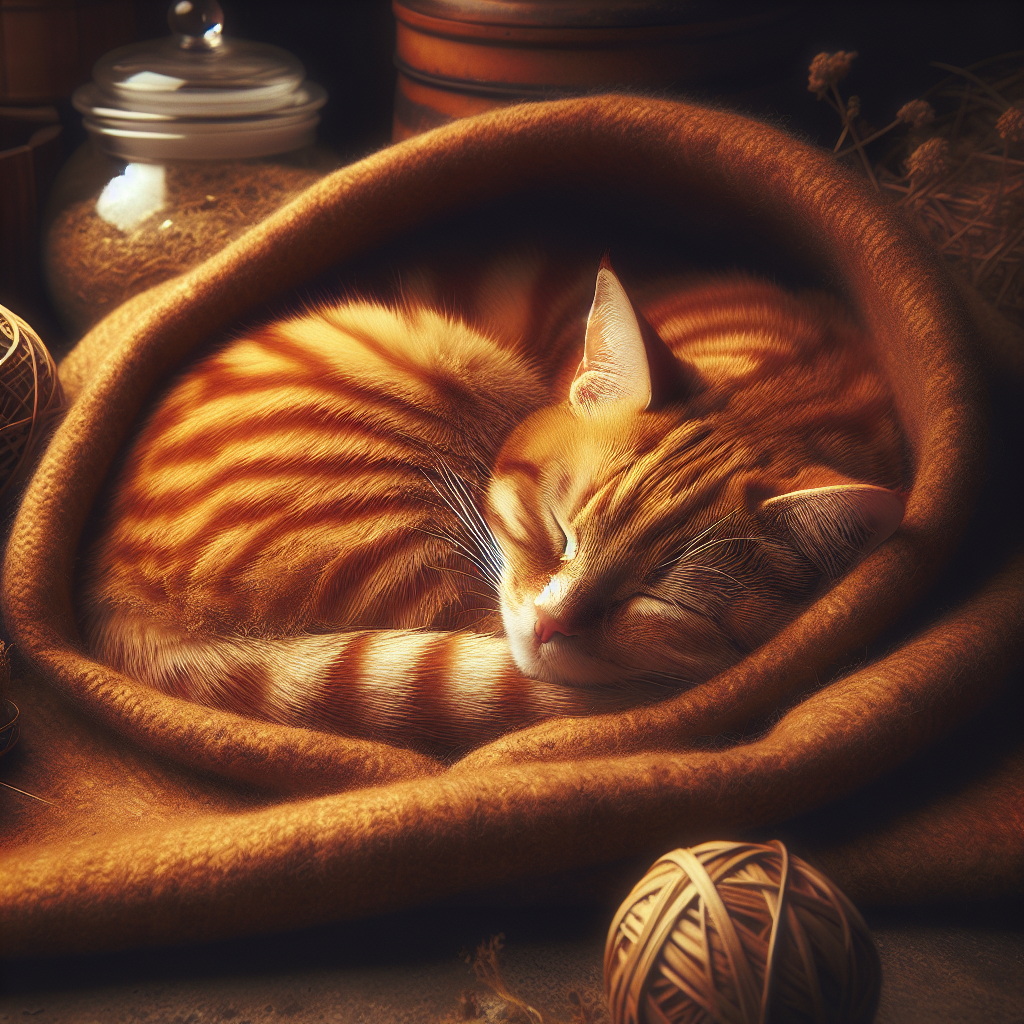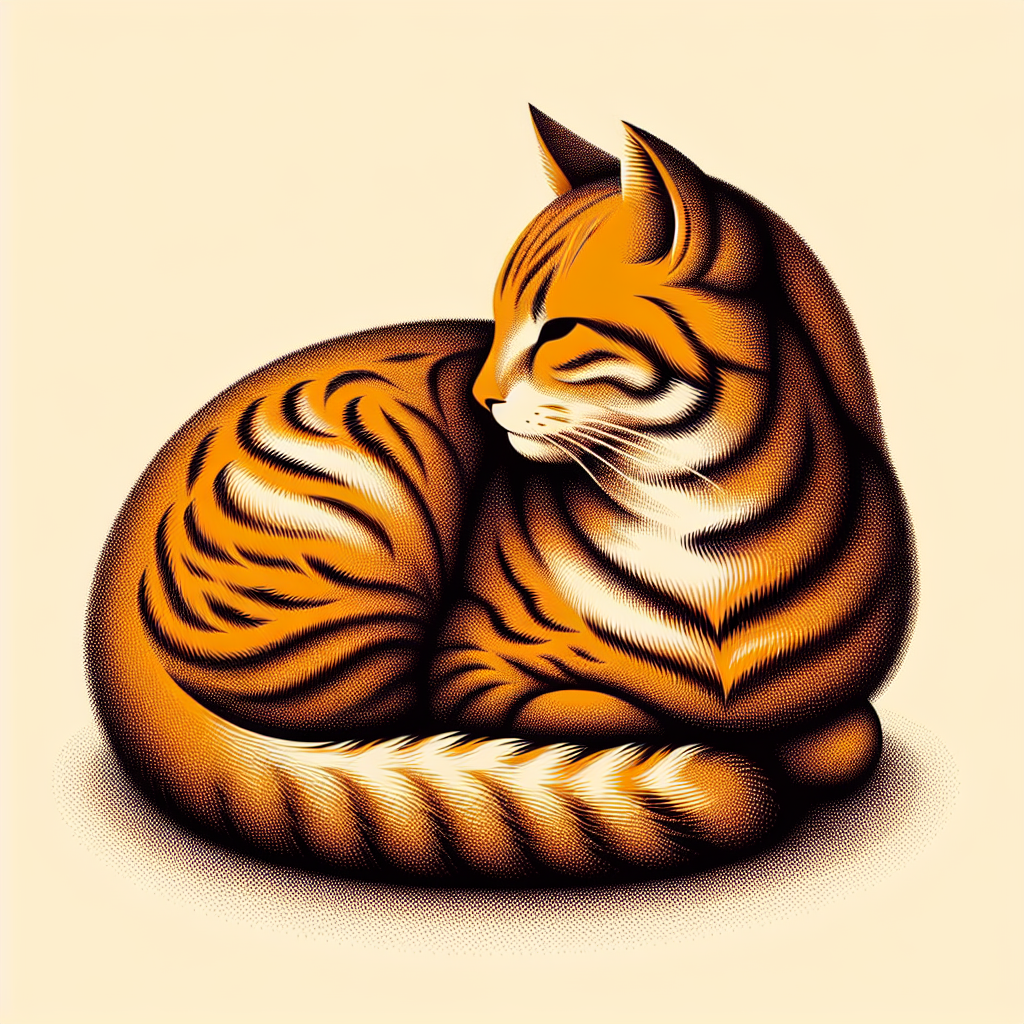Have you ever wondered if orange tabby cats have a mean streak? Well, let’s put that age-old debate to rest. In this article, we will delve into the temperament of these adorable feline friends. Orange tabby cats are known for their striking coat color, but are they truly as mean as some people believe? We’ll explore their unique characteristics, examine common misconceptions, and shed light on the truth about orange tabby cats. So, if you’re ready to uncover the real personality behind those beautiful orange stripes, let’s get started!

Physical Characteristics of Orange Tabby Cats
Coat Color
Orange tabby cats, also known as ginger cats, have a distinctive coat color that sets them apart from other feline breeds. Their fur ranges from a vibrant reddish-orange to a more subdued cream color, with variations depending on genetics. The tabby pattern is the most common pattern found in orange tabbies, which includes striped or marbled markings on their coat. However, it’s important to note that not all orange tabby cats have the same coat pattern, as some can have solid orange-colored fur without any distinctive stripes.
Tabby Stripes
One of the defining features of orange tabby cats is their tabby stripes. These stripes can appear in different patterns, such as classic, mackerel, ticked, or spotted. Classic tabbies have bold, swirling patterns that resemble the letter “M” on their forehead and stripes that run along their sides and back. In contrast, mackerel tabbies have narrower, parallel stripes, resembling fishbones. Ticked tabbies have a more speckled appearance, and spotted tabbies have distinctive spots instead of stripes. The combination of the orange coat color and tabby stripes contributes to the unique charm of orange tabby cats.
Eye Color
The eye color of orange tabby cats can vary, but most commonly, they have beautiful, expressive eyes that complement their coat color. The most prevalent eye colors seen in orange tabbies include shades of green and amber, which are known to enhance the overall appeal of these cats. It is important to note, though, that eye color can also be influenced by other factors such as genetics and individual variation.
Body Size and Weight
Orange tabbies come in all shapes and sizes, just like cats of any other breed. However, some general characteristics exist in terms of body size and weight. On average, adult orange tabby cats tend to have a medium to large build. They possess a sturdy and muscular physique, with males usually being larger and heavier than females. However, individual variations are common, and some orange tabbies may have a more petite frame. It is always essential to consider each cat as an individual and not make assumptions solely based on their coat color.
Personality Traits of Orange Tabby Cats
Friendly and Affectionate
Orange tabby cats are renowned for their friendly and affectionate nature. They often have a loving and easygoing disposition that makes them excellent companions. These cats thrive on human interaction, and they are known to shower their owners with warmth and love. Whether it’s snuggling up on your lap or purring contently by your side, orange tabbies are known for their ability to provide comfort and companionship.
Playful and Energetic
Don’t be surprised if your orange tabby cat initiates a game of play, as they are known for their playful and energetic nature. They have a zest for life and love engaging in activities that stimulate their minds and bodies. Orange tabbies enjoy chasing toys, batting at objects, and even playing a game of hide-and-seek. Keeping them entertained with interactive toys and playtime will not only provide them with mental stimulation but also help build a stronger bond between you and your feline friend.
Intelligent and Curious
Orange tabby cats possess a high level of intelligence and curiosity. They have an innate desire to explore their surroundings, investigate new scents, and discover hidden corners of your home. This curiosity, coupled with their sharp minds, helps them adapt quickly to new situations and learn from their experiences. Providing them with mental stimulation, such as puzzle toys or treat-dispensing toys, can help satisfy their inquisitive nature and prevent boredom.
Social and Outgoing
Orange tabby cats are known for their social and outgoing personalities. They typically enjoy the company of humans and animals alike, making them a great addition to any household. They are often welcoming to visitors and have a knack for putting a smile on people’s faces. Their friendly nature makes them adaptable and easy to bond with, making them a popular choice for families and individuals alike.
Independent and Self-Reliant
While orange tabby cats thrive on human interaction, they also have a streak of independence. They appreciate having their own space and time to relax. Unlike some other cats, they are confident in their own abilities and can handle being left alone for periods of time. However, it is crucial to ensure they have adequate mental stimulation and entertainment when they are on their own.
Factors Influencing Behavior of Orange Tabby Cats
Genetics
Genetics play a role in shaping the behavior of orange tabby cats, just like any other feline breed. Certain genetic traits can influence their personality, including their level of sociability, energy levels, and even the propensity for aggression. However, it is essential to remember that genetics alone do not determine a cat’s behavior, as environmental factors and individual experiences also play a significant role.
Early Socialization
Early socialization is crucial for any cat, including orange tabbies. Kittens that have positive experiences and interactions with humans, animals, and various environments during their early months are more likely to develop into sociable, well-adjusted adults. Proper socialization during early development helps shape their behavior, making them more confident, resilient, and adaptable throughout their lives.
Environmental Factors
The environment in which an orange tabby cat grows up significantly affects their behavior. Providing a safe and enriching environment is essential for their overall well-being. A stimulating living space that includes toys, scratching posts, and elevated spots can help satisfy their natural instincts. Additionally, exposure to various stimuli, such as different sounds and smells, can help develop their curiosity and resilience.
Health and Well-being
A cat’s physical health and overall well-being can have a significant impact on their behavior. Regular veterinary care, including vaccinations, parasite control, and wellness examinations, is crucial for maintaining a healthy orange tabby. Any underlying health conditions, such as pain or discomfort, can influence their behavior negatively. Ensuring their physical needs are met and providing a nutritious diet can contribute to their overall happiness and well-being.
Common Misperceptions About Orange Tabby Cats
Mean or Aggressive Behavior
One common misperception about orange tabby cats is that they possess a mean or aggressive nature. However, this is not indicative of their coat color. Just like any other cat, the behavior of an orange tabby cat is influenced by individual factors, genetics, and upbringing. While some orange tabbies may have a more assertive personality, it is not a characteristic exclusive to their coloration. Every cat is unique, regardless of their coat color, and generalizations should not be made based on stereotypes.
Association with Male Cats
Another misconception surrounding orange tabby cats is the assumption that they are predominantly male. This misconception likely stems from the belief that orange tabbies are always associated with male cats, while females are rare. However, the proportion of male to female orange tabby cats is not solely dictated by their coat color but rather the genetics of the breeding pair. Orange tabby cats can be found in both males and females, and their gender does not determine their personality or behavior traits.
Superstitions and Myths
In addition to the misconceptions mentioned above, there are various superstitions and myths related to orange tabby cats. Some people believe that owning an orange tabby brings good fortune, while others associate them with bad luck. However, these beliefs have no basis in reality and are purely a result of folklore and cultural superstitions. It’s important to approach these beliefs with a rational mindset and judge each cat based on their individual characteristics and behavior.

Understanding Cat Behavior
Cat Communication
Understanding how cats communicate is crucial for building a strong bond with your orange tabby. Cats use a combination of vocalizations, body language, and facial expressions to convey their needs, emotions, and intentions. Taking the time to learn their unique forms of communication can help you better understand their behavior and respond appropriately.
Territory and Marking Behavior
Cats, including orange tabbies, are territorial animals. They have a natural instinct to mark their territory, whether it’s through scent marking or scratching. This behavior serves as a way for cats to communicate with other cats and assert their presence. Providing appropriate scratching posts and allowing them to mark their territory can help fulfill these natural instincts and reduce the likelihood of destructive behavior.
Body Language Signals
A cat’s body language can provide valuable insights into their current mood and intentions. Understanding common body language signals, such as tail position, ear position, and eye dilation, can help you interpret and respond to your orange tabby’s behavior appropriately. For example, a tense body posture or flattened ears may indicate that your cat is feeling threatened or anxious, while a gently swaying tail can indicate relaxation or contentment.
Aggression Triggers
While orange tabby cats are generally friendly and affectionate, like any other cat, they can exhibit aggressive behavior in certain situations. Understanding the triggers for aggression can help prevent potential conflicts and create a safe environment for both you and your cat. Common triggers for aggression include fear, pain, territorial disputes, and lack of socialization. Recognizing these triggers and implementing appropriate behavior modification techniques can help manage and reduce aggressive tendencies.
Specific Behavior Patterns in Orange Tabby Cats
Clawing and Scratching
Clawing and scratching are natural behaviors for cats, including orange tabbies. Providing them with appropriate scratching posts and regularly trimming their claws can help redirect this instinctual behavior onto acceptable surfaces and prevent damage to furniture or other household items. Additionally, providing vertical and horizontal scratching options can cater to their individual preferences.
Spraying and Urine Marking
Urine marking is a behavior commonly seen in both male and female cats, including orange tabbies. While it can be frustrating for owners, it is important to understand that spraying is a natural form of communication for cats. Spaying or neutering your orange tabby at an appropriate age can help reduce or eliminate this behavior. Additionally, creating a clean and stress-free litter box environment can discourage inappropriate marking.
Biting and Aggressive Play
Some orange tabby cats, particularly when young, may engage in aggressive play behavior, which may involve biting or scratching. This behavior is generally a result of excess energy or a lack of appropriate play outlets. Providing interactive toys and scheduled play sessions can help redirect this energy into positive activities and prevent rough play with humans or other animals.
Excessive Vocalization
Orange tabby cats, like other cats, may exhibit excessive vocalization in certain situations. Excessive meowing or yowling can indicate various needs or emotions, such as hunger, boredom, stress, or seeking attention. Understanding the context and underlying cause of the vocalization can help address their needs appropriately. If excessive vocalization persists or is accompanied by other concerning behaviors, it is advisable to consult with a veterinarian to rule out any underlying medical issues.
Food-Related Behaviors
Orange tabby cats, like many other cats, can exhibit various food-related behaviors, such as begging or stealing food. These behaviors often stem from their natural instinct to hunt and secure food. Establishing consistent feeding routines, providing interactive feeders or puzzle toys, and ensuring a balanced and nutritious diet can help alleviate these food-related behaviors and promote healthy eating habits.
Tips for Managing and Shaping Orange Tabby Cat Behavior
Positive Reinforcement
Positive reinforcement is a powerful tool for shaping desired behaviors in orange tabby cats. Rewarding good behavior with treats, verbal praise, or playtime helps reinforce positive associations and encourages them to repeat those behaviors. It is important to remember that punishment or harsh disciplinary methods are not effective and can lead to fear or aggression.
Providing Enrichment and Stimulation
Orange tabby cats thrive in an environment that offers mental and physical stimulation. Providing toys that encourage interactive play, puzzle toys that challenge their problem-solving skills, and vertical spaces to climb and explore can help prevent boredom and destructive behavior. Additionally, rotating toys and offering new experiences periodically can keep them engaged and prevent them from becoming bored with their surroundings.
Establishing Routines and Boundaries
Cats, including orange tabbies, benefit from having established routines and boundaries. Consistency in feeding times, playtimes, and daily interactions helps create a sense of predictability, making them feel secure and minimizing stress. Additionally, setting appropriate boundaries by redirecting undesirable behaviors and using positive reinforcement techniques can help them understand acceptable behavior.
Socializing with Other Animals
Socialization with other animals, including cats and dogs, is essential for orange tabby cats. Introducing them to new animals gradually and under controlled circumstances can help them develop positive relationships. Early socialization can help prevent fear-based aggression or inappropriate behaviors towards other animals. Positive associations and supervised interactions can foster a harmonious and balanced environment with other household pets.
Regular Veterinary Care
Regular veterinary care is vital for maintaining the health and well-being of your orange tabby. Routine check-ups, vaccinations, and preventive measures, such as flea and tick control, are essential. In some cases, behavioral changes may be linked to underlying medical conditions. Regular veterinary visits can help identify and address any potential health issues that may contribute to behavioral changes.
Seeking Professional Help for Behavior Issues
Signs of Behavioral Problems
While most behavioral issues in cats can be managed with proper care and attention, certain signs may indicate the need for professional help. Persistent aggression towards humans or other animals, excessive fear or anxiety, destructive behaviors, persistent litter box issues, or any sudden and unexplained changes in behavior should be addressed by seeking professional guidance.
Consulting with a Veterinarian
Before seeking the help of an animal behaviorist, it is crucial to consult with a veterinarian. Medical conditions or discomfort can sometimes manifest as behavioral issues. A thorough physical examination and any necessary diagnostic tests can help determine if there are any underlying medical factors contributing to the behavior problems.
Working with an Animal Behaviorist
If behavioral issues persist or are not resolved through veterinary intervention alone, seeking the assistance of a certified animal behaviorist can be beneficial. These professionals have expertise in understanding and modifying animal behavior. They can develop personalized behavior modification plans based on your orange tabby’s specific needs, allowing you to work towards positive behavioral changes.
Conclusion
Orange tabby cats are not only visually striking but also possess a range of unique characteristics and behaviors that make them captivating companions. With proper understanding, care, and attention to their individual needs, orange tabbies can thrive in a loving and enriching environment. Remember, every cat, regardless of its coat color, is a distinct individual with its own personality and preferences. By celebrating and cherishing their individuality, you can cultivate a strong and mutually rewarding bond with your orange tabby cat.
Additional Resources
If you are interested in learning more about orange tabby cats and feline behavior, the following resources can provide further insight and guidance:
- Book: “The Total Orange Tabby Cat” by Katherine Smith
- Website: International Cat Care’s Orange Tabby Cats Guide
- Online Community: Orange Tabby Cat Owners Forum

